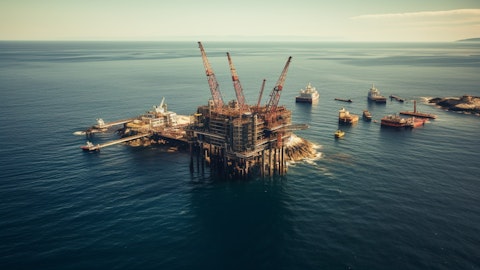Derrick Whitfield: Terrific. Thanks. Great quarter and update.
Travis Stice: Thanks, Derrick.
Kaes Van’t Hof: Thanks, Derrick.
Operator: Thank you. One moment for our next question. Our next question comes from Roger Read with Wells Fargo. Your line is now open.
Roger Read: Yes. Thank you. Good morning.
Travis Stice: Good morning, Roger.
Roger Read: I just wanted to come back, you talked earlier about some of these other benches that might work, and it’s a question of whether they’ll be as productive and efficient or the productivity and efficiency in those benches. Give us an idea of maybe some of the, let’s call it science or just applied efforts that you’re seeing that can open up some of these other benches. And I’m thinking within your footprint, as well as what will be an expanded footprint here before you’re in.
Kaes Van’t Hof: Roger, I mean I think for zones like the Wolfcamp D, we’ve had some testing on our assets, but also seen a lot of results across the fence line. Diamondback doesn’t spend a lot of time. We spend a lot of time looking ourselves. We also spend a lot of time looking across the fence line at what other people are doing, either through M&A process or just general competitor analysis. And we’ve seen that the Wolfcamp D has been very competitive, particularly in that kind of Midland Glasscock County line area. And also, as you get into Southern Martin County, so that’s getting more attention. I would say the Upper Spraberry, we’ve done a lot of work on ourselves, actually, an old energy well drilled in the Upper Spraberry in 2016 or 2017, and we revisited that well recently, last year, and some of the Upper Spraberry wells that we’ve completed, one in particular is probably one of the best wells in our portfolio.
So I’m not ready to say that the Upper Spraberry exists across our entire acreage position, but it’s certainly getting more capital and attention this year, and particularly with the co-development strategy and the fact that these zones talk to each other in some form or fashion means we’ve got to get it now. And so we’ve added the Upper Spraberry into our kind of Northern Martin County development plan. And I think the results speak for themselves because you haven’t seen a degradation in productivity. I think that’s the key to this exploration resource expansion story is, if you can expand your resource without impacting productivity, that’s a win for our shareholders.
Travis Stice: Roger, I’ll just add a comment from a high-level on what Kaes just mentioned. In my experience, as companies get bigger, the more inwardly focused they become. So they focus more on their own results and less on what others are doing around them. And it’s been a hallmark of Diamondback since the very beginning. One, you could say, out of necessity when we first started, but it’s been a hallmark of ours to really pay attention to what goes on around us. And so right now, it’s culturally ingrained not only to rigorously examine our own internal results, but also spend intellectual capital on looking across the barbed wire fence at what others are doing. And as we move into a much larger position post close, I promise you that culture will stay intact. We will continue to look and find what others are doing potentially better than we are and adopt accordingly.
Roger Read: I appreciate that clarification. That’s my only question. Thank you.
Travis Stice: Thanks, Roger.
Kaes Van’t Hof: Thanks, Roger.
Operator: Thank you. One moment for our next question. Our next question comes from Jeoffrey Lambujon with TPH & Co. Your line is now open.
Jeoffrey Lambujon: Good morning, everyone. I appreciate the time.
Travis Stice: Hey, Jeoff.
Jeoffrey Lambujon: My first question — hey, my first question is on the step change in capital efficiency you are looking forward to into 2025. Could you talk more about the pathway there? I know you’re already there for the legacy portfolio of, well cost, as you mentioned, Travis, but can you comment maybe on the larger buckets or moving pieces you’ll be focusing on the Endeavor side, both in terms of that well cost reduction and in terms of the non-DMC line items that you think about as we shift from this year into next.
Kaes Van’t Hof: Yes, Jeoff, I think generally there’s two big buckets on the DMC side that we see across fence Endeavor that we’ll probably look to put in place with the team there as we start to integrate on the completion side, it’s really the SimulFRAC development plan, as well as probably half of that plan being a SimulFRAC e-fleet, which only reduces the cost of the completion side of the business. I don’t even think we’ve modeled the benefits of a much larger supply chain to these numbers. This is just us getting their cost down to our costs on the capital side. So there’s probably some upside there at some point. And then on the drilling side, we’ve been a big proponent of clear fluids not using oil based mud to drill these wells.
It saves time and money. That was something we put in place and learned from the QEP team three or four years ago. And so I think that’s just a decision to make. That saves significant dollars. And what I’m excited about is to get under the tent with the Endeavor team and learn what they’re doing that we can do better, right? I think that’s not modeled in this pro forma business. And we’ve learned something from both energy and QEP are two large mergers that we’ve done to-date. So I think there’s some upside there. But really, all we’re doing is looking to put in place what we’re doing today on a larger asset base.




